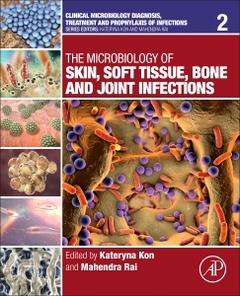Description
The Microbiology of Skin, Soft Tissue, Bone and Joint Infections
Clinical Microbiology Diagnosis, treatment and prophylaxis of infections Series
Coordinators: Kon Kateryna, Rai Mahendra
Language: English
Subject for The Microbiology of Skin, Soft Tissue, Bone and Joint...:
Keywords
<; p>; infections; skin; bone; joint; etiology; pathogenesis; diagnosis; prognosis; treatment; prophylaxis; Malassezia; Kingella kingae<; /p>
Support: Print on demand
Description
/li>Contents
/li>Readership
/li>Biography
/li>Comment
/li>
The Microbiology of Skin, Soft Tissue, Bone and Joint Infections: Volume 2 discusses modern approaches in diagnosis, treatment, and prophylaxis of skin, soft tissue, bone, and joint infections. The volume has been divided into three sections.
The first section includes chapters on diagnosis, treatment, and prophylaxis of skin and soft tissue infections. It discusses antimicrobial and surgical treatment of wounds, diabetic foot, and different soft tissue infections. Ten chapters are devoted to cutaneous and musculoskeletal infections in special groups of patients, which have their own specificity, i.e. in pediatric and HIV-infected patients. Together with chapters on commonly present diseases, there are chapters which discuss interesting but not well studied pathologies (natal cleft pilonidal sinus) and pathogens (Malassezia and Shewanella spp.).
The second section reviews etiology, pathogenesis, diagnosis and treatment of bone and joint infections, mainly osteomyelitis and prosthetic joint infections. Also, one chapter in this section discusses a newly emerging bacterial pathogen that causes skeletal infections, Kingella kingae. The third section incorporates alternative and new approaches?such as nanotechnology, ultrasound, novel delivery approaches and phyto-derived medicines?to the treatment and prophylaxis of skin, soft tissue, bone, and joint infections.
Section I: Skin and Soft Tissue Infections: Diagnosis and Treatment1. Soft Tissue Infections: Consideration Regarding Different International Guidelines2. Evidence-Informed Approach to Pilonidal Sinus Disease and Related Disorders3. The Microbiome of Diabetic Foot Ulcers and the Role of Biofilms4. Cutaneous and Musculoskeletal Complications in Human Immunodeficiency Virus Infection5. Diseases Caused by Malassezia Species in Human Beings6. Skin and Soft Tissue Infections Following Marine Injuries7. Gordonia and Related Genera as Opportunistic Human Pathogens Causing Infections of Skin, Soft Tissues, and Bones
Section II: Bone and Joint Infections: Diagnosis and Treatment8. The Molecular Mechanics of Inflammatory Bone and Joint Disease Caused by Microbial Infection9. Microbiological Diagnosis of Prosthetic Joint Infections10. Laboratory Detection of the Emergent Pathogen Kingella kingae in Children With Septic Arthritis
Section III: Alternative and Novel Approaches to the Diagnosis and Treatment of Skin, Soft Tissue, Bone, and Joint Infections11. Nanotechnology for the Treatment of Fungal Infections on Human Skin12. Alternative Antimicrobials from Natural Products Against Dermatological Infections13. Medicinal Plants Versus Skin Disorders: A Survey From Ancient to Modern Herbalism14. Natural Products as Source of New Antimicrobial Compounds for Skin Infections15. Role of Medicinal Plants and Bioactive Compounds Against Skin Disease–Causing Microbes, With Special Emphasis on Their Mechanisms of Action16. Antimicrobial Strategies in Novel Drug Delivery Systems: Applications in the Treatment of Skin and Soft Tissue Infections17. Medical, Surgical Therapy, and Alternative Treatment of Infected Vascular Grafts18. Dermoscopy Findings in Infectious and Parasitic Diseases
teachers of universities, medical practitioners, graduate and postgraduate students, researchers in microbiology, in different medical specialties, pharmacology, biotechnology, and specialists from pharmaceutical and laboratory diagnostic companies
Dr. Kon's scientific contributions include more than 100 publications, 6 books and 18 scientific articles. The main focus of Dr. Kon’s research is antibiotic resistance in bacteria, coping with microbial resistance by plant essential oils and nanoparticles, microbiology of surgical and gynaecological infections, application of different statistical methods to analysis of biomedical data.
Professor Mahendra Rai is a UGC-Basic Science Research Faculty Fellow and former head of the Department of Biotechnology, Sant Gadge Baba Amravati University, India. Presently, he is a visiting Scientist at the Department of Microbiology, Nicolaus Copernicus University, Poland. His areas of expertise include microbial biotechnology and nanobiotechnology. Currently, his group’s main research interest is green synthesis of metal nanoparticles particularly using fungi and their applications as nanoantimicrobials against pathogenic microbes. Prof. Rai has received several prestigious awards, including the Medini Award by the Government of India. He has been featured in Stanford’s list of the top 2% of scientists in nanoscience.
- Encompasses a broad range of skin, soft tissue, bone, and joint infections, including questions of etiology, pathogenesis, diagnosis, prognosis, treatment, and prophylaxis
- Written by highly professional and eminent surgeons, microbiologists, and infectious disease specialists
- Discusses topics using modern insight, providing all necessary scientific information on each aspect
- Includes scientific understanding and practical guidelines, which make it interesting for both research scientists and practitioners working with skin, soft tissue, bone, and joint infections




